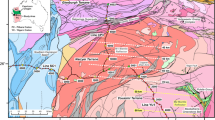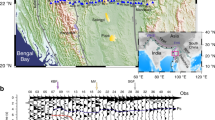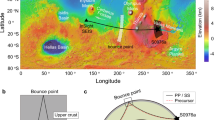Abstract
The present day continental crust beneath stable cratons is generally thought to be 30–50 km thick1,2 although there are divergent views as to its initial thickness and the associated thermal and tectonic regimes3,4. Likewise, the lithosphere is believed to have been thinner in the Archaean, but its relationship to the crust at that time has not been specified. Structural details regarding the Archaean crust revealed by a Deep Seismic Sounding (DSS) study across the South Indian Craton5, supplemented by similar data from the Ukrainian Shield1, show a relationship between crust and mantle which apparently places important constraints on the thermo-tectonic conditions prevailing at the time of formation of the crust. We interpret these details as indicating that at one time the crust constituted the lithosphere, the Moho marking its base.
This is a preview of subscription content, access via your institution
Access options
Subscribe to this journal
Receive 51 print issues and online access
$199.00 per year
only $3.90 per issue
Buy this article
- Purchase on Springer Link
- Instant access to full article PDF
Prices may be subject to local taxes which are calculated during checkout
Similar content being viewed by others
References
Sollogub, V. B., Prosen, D. & Militzer, H. (eds) Geophys. Trans. Hungarian Geophys. Inst. (spec, edn 1972).
Bamford, D. & Prodehl, C. J. geol. Soc. 134, 139–151 (1977).
Condie, K. C. Plate Tectonics and Crustal Evolution (Pergamon, New York, 1976).
Fyfe, W. S. Nature 249, 338 (1974).
Kaila, K. L. et al. J. geol. Soc. Ind. 20, 307–333 (1979).
Crawford, A. R. J. geol. Soc. Ind. 10, 117–166 (1969).
Venkatasubramaniam, V. S. & Narayana Swami, R. J. geol. Soc. Ind. 15, 77–80, 200–204, 318–319 (1974).
Ikramuddin, M. & Stueber, A. M. Lithos 9, 235–240 (1976).
Beckinsale, R. D., Drury, S. A. & Holt, R. W. Nature 283, 469–470 (1980).
Crawford, A. R. & Compston, W. J. geol. Soc. Austr. 19, 453–464 (1973).
Phinney, R. A. EOS 59, 389 (1978).
Smithson, S. B. Contr. Geol. Univ. Wyoming 17, 65–75 (1979).
O'Hara, M. J. J. geol. Soc. 134, 185–200 (1977).
Rao, R. U. M., Rao, G. V. & Narain, H. Earth planet. Sci. Lett. 30, 57–64 (1976).
Watson, J. V. Phil. Trans. R. Soc. A288, 431–440 (1978).
Phillips, R. J. & Ivins, E. R. Phys. Earth planet. Inter. 19, 107–148 (1979).
Cook, F. A., Brown, L. D. & Kaufmann, S. EOS 59, 389 (1978).
Naqvi, S. M., Rao, V. D. & Narain, H. Precambr. Res. 6, 323–345 (1978).
Author information
Authors and Affiliations
Rights and permissions
About this article
Cite this article
Chowdhury, K., Hargraves, R. Deep seismic soundings in India and the origin of continental crust. Nature 291, 648–650 (1981). https://doi.org/10.1038/291648a0
Received:
Accepted:
Issue Date:
DOI: https://doi.org/10.1038/291648a0
This article is cited by
-
Seismic Structure of the Crust and Lithospheric Mantle of the Indian Shield: A Review
Journal of the Geological Society of India (2021)
-
Seismic Structure of the Central Indian Crust and its Implications on the Crustal Evolution
Journal of the Geological Society of India (2019)
-
Identifying the Transition Zone Between East and West Dharwar Craton by Seismic Imaging
Pure and Applied Geophysics (2018)
-
Geoelectric structure of northern Cambay rift basin from magnetotelluric data
Earth, Planets and Space (2017)
-
Tectonics of proterozoic Cuddapah Basin, southern India: A conceptual model
Journal of the Geological Society of India (2011)
Comments
By submitting a comment you agree to abide by our Terms and Community Guidelines. If you find something abusive or that does not comply with our terms or guidelines please flag it as inappropriate.



